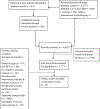The impact of behavioral interventions on cognitive function in healthy older adults: A systematic review
- PMID: 31002885
- PMCID: PMC8830244
- DOI: 10.1016/j.arr.2019.04.002
The impact of behavioral interventions on cognitive function in healthy older adults: A systematic review
Abstract
Behavioral interventions to improve cognitive function in older adults are widespread and can vary from theater classes to cognitive training programs. However, the effectiveness in maintaining different cognitive domains varies greatly both across and within intervention types. To date, no systematic reviews have synthesized findings across more than a few types of interventions (e.g., cognitive vs. exercise). This systematic review examined 11 types of behavioral interventions and the respective transfer to 19 cognitive domains, as well as transfer to everyday function. Study inclusion criteria were: peer-reviewed articles in English, samples of healthy adults aged 65 and older, and randomized controlled trials of behavioral interventions with reported cognitive outcomes. The 2017 search yielded 75 eligible articles comprising cognitive training, exercise training, combination interventions, cognitively-stimulating activities, and action video games. In general, process- (n = 26) and strategy-based (n = 16) cognitive training improved the trained domains but had weak transfer to non-trained domains. Aerobic training (n = 13) most consistently improved executive function, and strength/resistance (n = 8) and aerobic/resistance combination training (n = 6) most consistently improved cognitive inhibition and visual working memory. Combination interventions (n = 15 nonfactorial, n = 3 factorial) showed promise in improving verbal delayed recall and executive function. Few studies examined cognitively-stimulating activities or action video games, leaving inconclusive results about their effect on cognitive function. Few studies examined everyday function (n = 9), however, process- and strategy-based training demonstrated notable long-term transfer. Recommendations for future research and practice are highlighted.
Keywords: Cognition; Cognitive training; Exercise training; Healthy older adults; Randomized controlled trial; Systematic review.
Copyright © 2019 Elsevier B.V. All rights reserved.
Conflict of interest statement
Conflict of interest
All authors have no conflicts of interest.
Figures








Similar articles
-
Enrichment Effects on Adult Cognitive Development: Can the Functional Capacity of Older Adults Be Preserved and Enhanced?Psychol Sci Public Interest. 2008 Oct;9(1):1-65. doi: 10.1111/j.1539-6053.2009.01034.x. Epub 2008 Oct 1. Psychol Sci Public Interest. 2008. PMID: 26162004
-
Effects of physical exercise on executive function in cognitively healthy older adults: A systematic review and meta-analysis of randomized controlled trials: Physical exercise for executive function.Int J Nurs Stud. 2021 Feb;114:103810. doi: 10.1016/j.ijnurstu.2020.103810. Epub 2020 Oct 24. Int J Nurs Stud. 2021. PMID: 33248291
-
Cognitive Interventions for Cognitively Healthy, Mildly Impaired, and Mixed Samples of Older Adults: A Systematic Review and Meta-Analysis of Randomized-Controlled Trials.Neuropsychol Rev. 2017 Dec;27(4):403-439. doi: 10.1007/s11065-017-9350-8. Epub 2017 Jul 19. Neuropsychol Rev. 2017. PMID: 28726168
-
Multiple roads lead to Rome: combined high-intensity aerobic and strength training vs. gross motor activities leads to equivalent improvement in executive functions in a cohort of healthy older adults.Age (Dordr). 2014;36(5):9710. doi: 10.1007/s11357-014-9710-8. Epub 2014 Sep 7. Age (Dordr). 2014. PMID: 25194940 Free PMC article.
-
Immediate and long-term efficacy of executive functions cognitive training in older adults: A systematic review and meta-analysis.Psychol Bull. 2019 Jul;145(7):698-733. doi: 10.1037/bul0000196. Epub 2019 Apr 18. Psychol Bull. 2019. PMID: 30998045
Cited by
-
Do Musicians Have Better Mnemonic and Executive Performance Than Actors? Influence of Regular Musical or Theater Practice in Adults and in the Elderly.Front Hum Neurosci. 2020 Sep 15;14:557642. doi: 10.3389/fnhum.2020.557642. eCollection 2020. Front Hum Neurosci. 2020. PMID: 33100995 Free PMC article.
-
Effects of foreign language learning on executive functions in healthy older adults: study protocol for a randomised controlled trial.BMC Geriatr. 2021 Feb 15;21(1):122. doi: 10.1186/s12877-021-02051-x. BMC Geriatr. 2021. PMID: 33588784 Free PMC article.
-
Facilitation of working memory capacity by transcranial direct current stimulation: a secondary analysis from the augmenting cognitive training in older adults (ACT) study.Geroscience. 2024 Oct;46(5):4075-4110. doi: 10.1007/s11357-024-01205-0. Epub 2024 May 25. Geroscience. 2024. PMID: 38789832 Free PMC article. Clinical Trial.
-
Mentally Challenging Occupations Are Associated With More Rapid Cognitive Decline at Later Stages of Cognitive Aging.J Gerontol B Psychol Sci Soc Sci. 2021 Mar 14;76(4):671-680. doi: 10.1093/geronb/gbz122. J Gerontol B Psychol Sci Soc Sci. 2021. PMID: 31560775 Free PMC article.
-
The Effects of Acute Exercise on Driving and Executive Functions in Healthy Older Adults.Int J Sport Exerc Psychol. 2022;20(1):283-301. doi: 10.1080/1612197x.2020.1849353. Epub 2020 Nov 20. Int J Sport Exerc Psychol. 2022. PMID: 35401070 Free PMC article.
References
-
- Alsubaie M, Abbott R, Dunn B, Dickens C, Keil TF, Henley W, Kuyken W, 2017. Mechanisms of action in mindfulness-based cognitive therapy (MBCT) and mindfulness-based stress reduction (MBSR) in people with physical and/or psychological conditions: a systematic review. Clin. Psychol. Rev. 55, 74–91. 10.1016/j.cpr.2017.04.008. - DOI - PubMed
-
- Andrews JS, Desai U, Kirson NY, Enloe CJ, Ristovska L, King S, ... Kahle-Wrobleski K, 2017. Functional limitations and health care resource utilization for individuals with cognitive impairment without dementia: findings from a United States population-based survey. Alzheimer’s Demen. Diagn. Assess. Dis. Monitor. 6, 65–74. 10.1016/j.dadm.2016.11.005. - DOI - PMC - PubMed
-
- *Bakken RC, Carey JR, Di Fabio RP, Erlandson TJ, Hake JL, Intihar TW, 2001. Effect of aerobic exercise on tracking performance in elderly people: a pilot study. Phys. Ther. 81 (12), 1870–1879. - PubMed
Publication types
MeSH terms
Grants and funding
LinkOut - more resources
Full Text Sources
Medical

